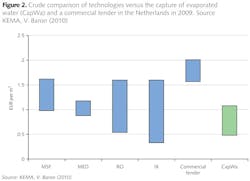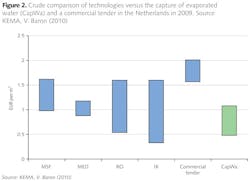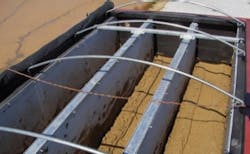By Ron Brown
The city of Bremerton, WA, is currently planning its compliance approach for the Long Term 2 Enhanced Surface Water Treatment Rule (LT2ESWTR), which was promulgated by the USEPA in January 2006. This regulation required treatment enhancements for the city's Union River surface water supply, which is currently operating under the filtration avoidance criteria of the Surface Water Treatment Rule (SWTR).
The city proposed implementing a new multiple-barrier disinfection approach that consists of ultraviolet (UV) irradiation followed by free chlorination. In addition to the disinfection improvements for LT2ESWTR compliance, the city also proposed other system modifications and improvements designed to enhance surface water supply flexibility and improve operations associated with surface water flow diversions to the Twin Lakes Reservoir, which is an aquifer recharge basin that supplies numerous nearby groundwater wells in their water system.
The project was given a jump start when money became available through the American Recovery and Reinvestment Act of 2009. The ARRA funds made it possible for the city to proceed with the project with minimal rate impacts to the city, which has been strongly impacted by the recent economic downturn.
Current System
The City of Bremerton currently relies on a combination of surface water and groundwater to optimize the balance among water demand, supply and quality. At present, the Union River provides about 60 percent of the city's annual water supply, with the balance provided by several groundwater wells.
Aerial view of proposed site of the Bremerton UV Treatment Facility.
Due to the source water quality and the city's comprehensive watershed control program and effective land and forestry management, the Union River supply has been successfully operated under SWTR filtration avoidance requirements. For this project, it is assumed that the Union River source will retain its unfiltered status and that filtration will not be required for LT2ESWTR compliance or other drinking water regulations in the foreseeable future.
The LT2ESWTR requires that unfiltered surface water supplies be disinfected to inactivate Cryptosporidium, and that the treatment include a minimum of two separate disinfectants to meet the combined pathogen inactivation requirements of SWTR (2- or 3-log Giardia lamblia) and LT2SWTR (2- or 3-log Cryptosporidium). The application of chlorine disinfection alone, as currently practiced, would not be sufficient as it is not effective at inactivating Cryptosporidium. Although the City of Bremerton has never found Cryptosporidium in its surface water, LT2ESWTR compliance requires the inactivation of Cryptosporidium in unfiltered surface water supplies
The city's Union River surface supply originates at the Casad Reservoir. Water is released into a river and flows to the McKenna Falls Intake Facility, where it is screened, monitored for turbidity, flow-metered and chlorinated using one-ton gas containers for primary disinfection. The treated water enters a transmission main and flows through about 37,600 feet of piping to Reservoir 4, the current point of entry to the distribution system (W256 pressure zone). Travel time in the transmission main provides more than enough chlorine contact time to satisfy SWTR treatment requirements.
Project drivers
The city retained HDR to provide engineering design and construction support services for the Ultraviolet Disinfection Treatment Facility project. The objectives of the water system's improvement project were to:
- Provide multiple-barrier disinfection of the unfiltered Union River surface supply to ensure compliance with both SWTR and LT2ESWTR and enhance drinking water quality.
- Give the city flexibility to supply treated Union River water to the W517 zone in addition to the W256 zone currently used. The W517 zone is currently considered by the Department of Health to be a separate water system.
- Improve operations associated with flow control and diversion of unchlorinated Union River Water to the Twin Lakes Reservoir recharge basin.
Proposed Solution
Ultraviolet radiation (UV) was the recommended and chosen disinfection approach for LT2ESWTR compliance. Further evaluation of the advantages and disadvantages of various configurations of UV systems such as low pressure/high output versus medium pressure was conducted. The city chose to preselect and procure a medium pressure system after soliciting proposals and bids through a competitive process.
Pictured is a medium pressure UV system similar to what is planned for Bremerton.
Chlorination options were evaluated including bulk and onsite generated liquid sodium hypochlorite. HDR recommended the installation of a bulk liquid system at the new treatment facility. The new hypochlorite system would provide for SWTR compliance required and the maintenance of a chlorine residual in the treated water distribution system.
To achieve other objectives for the project, HDR investigated the relocation of the point of chlorination that would allow diversion into the Twin Lakes reservoir for recharge and provide treated water into the city's water system. It was decided that siting the new treatment facilities adjacent to the Twin Lakes control valve facility would facilitate the system flexibility desired by the city. In addition, the city was concerned with the continued use of gaseous chlorine in a location that was closer to more populated areas and the city's golf course.
The UV and the liquid chlorination systems were installed in a new, hardened facility to provide a greater level of security for this critical component of the city's potable water system.
Stimulus Funding
This project was made possible through the ARRA stimulus funding program. The construction of the system improvements not only added jobs in the local economy during construction but will also ensure compliance with state and federal water quality requirements by the city's water system for years to come. WW
About the Author:
Ron Brown, P.E., is a water reuse program manager based in HDR's Bellevue, WA, office. He has more than 30 years of industry experience.
More WaterWorld Current Issue Articles
More WaterWorld Archives Issue Articles





